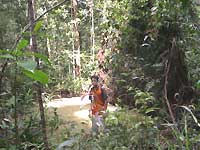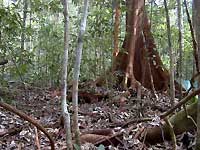(3) I conducted research in a tropical peat swamp forest in Kermutan Wildlife Sanctuary, Riau Province, East Sumatra, Indonesia in May 2003. The result of spatial point pattern analysis indicated that different types of habitats regulate the regeneration process according to flood-tolerance of trees, and contribute to species coexistence. For example, around the large buttresses there were fewer juveniles of flood-tolerant species and vice versa.
I studied matter production and nutrient cycles (ingrowth cores, litter traps and decomposition experiments) on different habitats. It was revealed that habitats are maintained by different regimes of decomposition and production, and changes in the balance between production and decomposition lead to changes of microtopography. For example, disturbances of buttressed trees cause the disappearance of mounds because of degraded production, and the establishment of large buttressed trees results in the creation of mounds because of increasing production. The dynamics of microtopography explain the species coexistence on a spatio-temporal scale. The creation and disappearance of mounds provide regeneration niches for flooding-intolerant and -tolerant species, respectively.


 21st Century COE Program
-Aiming for COE of Integrated Area Studies-
21st Century COE Program
-Aiming for COE of Integrated Area Studies-